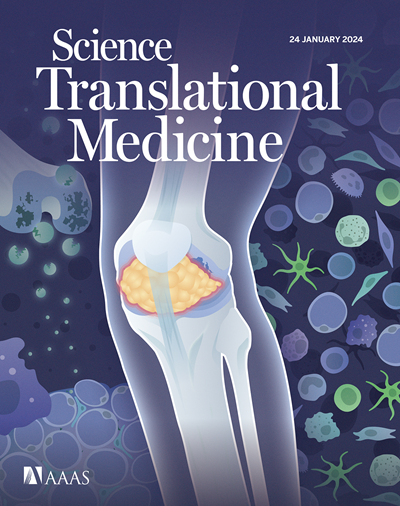在关节软骨修复的随机多中心试验中工程化软骨成熟的临床意义
IF 15.8
1区 医学
Q1 CELL BIOLOGY
引用次数: 0
摘要
软骨损伤不能自发愈合,易患骨关节炎。在临床前研究中,使用自体软骨细胞工程化的功能性软骨组织比传统的细胞疗法具有治疗优势。在这里,我们测试了用于软骨修复的工程移植物的体外成熟是否会改善患者的获益。使用自体鼻软骨细胞(nc),我们测试了在局灶性软骨病变中植入体外成熟的nc组织工程软骨(N-TEC)与未分化的nc细胞活化基质(N-CAM)是否会产生更好的临床结果。这项前瞻性、随机、平行、开放标签的2期试验(ClinicalTrials.gov, NCT02673905)纳入了来自4个国家5家医院的108名患者。年龄从30岁到46岁的全层膝关节软骨缺损(尺寸为2.7到6.0平方厘米)患者同样随机接受N-TEC或N-CAM治疗。预登记的主要结局是24个月时膝关节损伤骨关节炎结局评分(oos)。经过较长NC培养时间的N-TEC在表型、结构和功能上都比N-CAM更像透明软骨。与术前相比,两组患者的总体kos随临床相关性而增加。N-TEC患者24个月时KOOS较高[85;四分位间距(IQR), 74 ~ 91]比N-CAM (79;IQR, 65至85)。N-TEC,而不是N-CAM,对较大缺损或翻修手术的患者同样有效。放射学上,N-TEC导致修复组织和周围软骨的优越组成,而结构评分相似。该试验验证了基于nc的移植物用于关节软骨修复的临床疗效,并支持工程成熟组织的临床相关性,即使对于更具挑战性的软骨缺陷患者也是如此。本文章由计算机程序翻译,如有差异,请以英文原文为准。
Clinical relevance of engineered cartilage maturation in a randomized multicenter trial for articular cartilage repair
Cartilage lesions do not heal spontaneously and predispose to osteoarthritis. Functional cartilage tissues, engineered using autologous chondrocytes, have a therapeutic advantage over conventional cellular therapies in preclinical studies. Here, we tested whether ex vivo maturation of engineered grafts for cartilage repair leads to improved patient benefit. Using autologous nasal chondrocytes (NCs), we tested whether implantation of in vitro–matured NC-tissue-engineered cartilage (N-TEC) versus undifferentiated NC-cell-activated matrices (N-CAM) in focal cartilage lesions would result in a superior clinical outcome. The prospective, randomized, parallel, open-label phase-2 trial ( ClinicalTrials.gov , NCT02673905) enrolled 108 patients in five hospitals from four countries. Patients ranging in age from 30 to 46 years with full-thickness knee cartilage defects (size, 2.7 to 6.0 square centimeters) were equally randomized and treated with N-TEC or N-CAM. The primary preregistered outcome was the overall Knee Injury Osteoarthritis Outcome Score (KOOS) at 24 months. N-TEC, which underwent a longer NC culture time, was phenotypically, structurally, and functionally more like hyaline cartilage than N-CAM. The overall KOOS increased with clinical relevance in both groups compared with preoperative values. KOOS was higher at 24 months for N-TEC [85; interquartile range (IQR), 74 to 91] than for N-CAM (79; IQR, 65 to 85). N-TEC, but not N-CAM, was similarly effective in patients with larger defects or revision surgery. Radiologically, N-TEC resulted in a superior composition of both repair tissue and surrounding cartilage, whereas structural scores were similar. This trial validates the clinical efficacy of NC-based grafts for articular cartilage repair and supports the clinical relevance of engineering mature tissues, even for patients with more challenging cartilage defects.
求助全文
通过发布文献求助,成功后即可免费获取论文全文。
去求助
来源期刊

Science Translational Medicine
CELL BIOLOGY-MEDICINE, RESEARCH & EXPERIMENTAL
CiteScore
26.70
自引率
1.20%
发文量
309
审稿时长
1.7 months
期刊介绍:
Science Translational Medicine is an online journal that focuses on publishing research at the intersection of science, engineering, and medicine. The goal of the journal is to promote human health by providing a platform for researchers from various disciplines to communicate their latest advancements in biomedical, translational, and clinical research.
The journal aims to address the slow translation of scientific knowledge into effective treatments and health measures. It publishes articles that fill the knowledge gaps between preclinical research and medical applications, with a focus on accelerating the translation of knowledge into new ways of preventing, diagnosing, and treating human diseases.
The scope of Science Translational Medicine includes various areas such as cardiovascular disease, immunology/vaccines, metabolism/diabetes/obesity, neuroscience/neurology/psychiatry, cancer, infectious diseases, policy, behavior, bioengineering, chemical genomics/drug discovery, imaging, applied physical sciences, medical nanotechnology, drug delivery, biomarkers, gene therapy/regenerative medicine, toxicology and pharmacokinetics, data mining, cell culture, animal and human studies, medical informatics, and other interdisciplinary approaches to medicine.
The target audience of the journal includes researchers and management in academia, government, and the biotechnology and pharmaceutical industries. It is also relevant to physician scientists, regulators, policy makers, investors, business developers, and funding agencies.
 求助内容:
求助内容: 应助结果提醒方式:
应助结果提醒方式:


